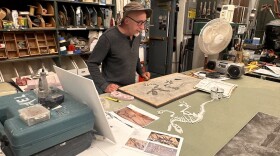-
Scientists have developed a new way to study really small fish. They’ve designed a tag that’s about the size of a grain of rice.
-
Using satellite remote sensing to measure water temperature has been heavily underutilized, said Faisal Hossain, a professor at the University of…
-
$1M National Science Foundation grant could help researchers plan for wildfire-related power outagesThe grant will help researchers develop a wildfire simulator and a tool that predicts power outages. The tool will help them study Northwestern landscapes, characteristics of communities and ignition sources.
-
Sensors developed in part by Washington State University could test your smoke exposure before health problems crop up.
-
(Runtime 3:31)Robots have taken over the STEM room at Marcus Whitman Elementary School in Richland, Washington.Little Lego boats, sunken ships and other…
-
(Runtime 1:08)Around 50 people lined First Street in Yakima Friday, waving their hands and holding signs in support of science. The protest was part of…
-
(Runtime 1:06)Giant ships that transport everything from coffee cups to clothes across the ocean are often so large they can’t tell when they collide with…
-
Astronauts and space shuttles constantly are bombarded by radiation. An experiment designed in the Northwest blasted into space today. It’s helping…
-
(Runtime 4:14) In the shadow of Mount St. Helens’ summit, 20 girls spent a week studying pumice, ash and lava at a GeoGirls camp. The famous Washington…
-
In a big, open room in the basement of Bellingham’s old city hall, little cupboards line the walls holding spray paint, different kinds of tape, cans of WD-40, and at least four different handheld drills. Wearing round-framed glasses and an explorer’s hat, museum preparator David Miller stands over the work table, messy with progress. He is sculpting fake dinosaur bones. They will be hidden in a box and covered with sand for children to posture as paleontologists, uncovering the creatures of prehistoric past.
Play Live Radio
Next Up:
0:00
0:00
Available On Air Stations










